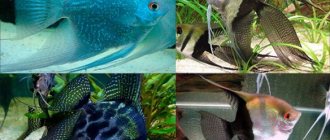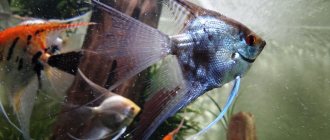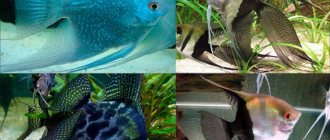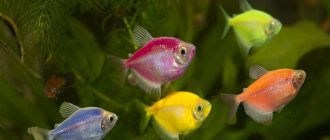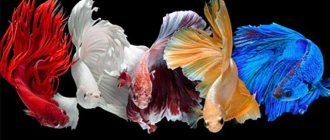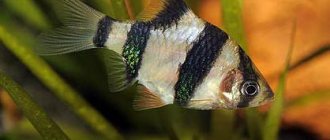Experienced aquarists know: before getting a scaly pet, you need to find reliable information about its compatibility with certain species. Some fish can offend others, cause injuries and even eat them. For example, angelfish are considered one of the most difficult fish and difficult to care for for beginner aquarists. In order to maintain peace and tranquility in the aquarium, you need to study the habits of the angelfish and compatibility with other fish.
Description of the species
This type of aquarium fish comes from South America - the central part of the Amazon River basin, which corresponds to the territory of Peru, Ecuador and Brazil. Angelfish are predators that feed on the fry of other fish, small crustaceans, insects and other invertebrates. Sometimes fish can eat aquatic plants as a snack.
The beautiful appearance of these aquarium pets - the triangular body shape, yellow, golden and white with black stripes made this species one of the most popular among breeders. In captivity, angelfish live 5-6 years; in the wild, oddly enough, they live up to 11-12 years. They can reach 12-15 centimeters in length. They prefer brine shrimp and bloodworms as food – frozen, dried or live.
Angelfish became popular as an aquarium pet already in the thirties of the last century. Many breeds have been developed from just three wild subspecies: Pterophyllum Scalare, Pterophyllum Leopoldi and Pterophyllum Altum.
Content Features
The species is considered relatively easy to keep, but is not very suitable for beginners who do not know many of the nuances of behavior and cultivation of small predators, which include representatives of the Cichlid family. Like all perciformes, angelfish are unpretentious and are rightfully considered caring parents.
Fish need the following parameters:
- The minimum volume of the aquarium is 100 liters. Ideally, the container should have a volume of 250 liters or more.
- Comfortable ambient temperature is 22-27 °C.
- Water acidity range – 6-7.5 pH.
- The water hardness in the aquarium is 10 dH.
- Fish do not jump out of the water, so it is not necessary to cover the aquarium with a lid.
- Lighting is moderate; some areas need to be shaded with aquatic plants.
- You can decorate the aquarium with whatever you want, but you should leave plenty of free space for free swimming.
Fish are unpretentious in food, prefer live food, but eat frozen and dried types of food with equal appetite. An ideal diet should consist of bloodworms, brine shrimp, bark, daphnia, and cyclops. Angelfish can go without food for about two weeks - they rarely eat, so this behavior is considered normal.
Character angelfish
Representatives of this species are schooling fish; they must be placed in the aquarium at least 3-5 at a time, taking into account the fact that they form long-term pairs. This species is the most peaceful among Cichlids, but their restlessness can play a cruel joke.
Very often, angelfish divide territory, and alpha individuals can injure weaker relatives. This also applies to other species: active “angels” love to bully slow-moving fish, some even tear off their fins and gnaw out their eyes. Therefore, it is very important to choose the right neighbor so as not to personally send your pets to certain death.
Nuances of choosing neighbors
Keeping angelfish with representatives of another species is quite problematic. If you want to add someone to this fish, you need to follow a number of simple rules regarding the nature of the pets and the conditions of detention.
Main nuances:
- “Angels,” like all Cichlids, are heat-loving representatives of the underwater kingdom. Their neighbors should feel comfortable in the same temperature range.
- All conditions (hardness, acidity, lighting, aeration, water speed) in a community aquarium should be optimal for residents.
- A sufficient amount of free space is necessary for each individual and the species as a whole.
- You can’t add small neighbors - for stronger ones they will be perceived as food. There is another extreme: large species can bite off the fins and tails of angelfish.
- Neighbors should be relatively slow; very fast species will annoy angelfish.
- It is better to place the fish with each other when they are still young, so that they get used to each other and get along better in the future.
- Some "bullies" can be found among any species. They need to be moved out so that they do not disturb the peace in the entire aquarium.
If you follow all these rules, you don’t have to worry about the health and well-being of neighboring fish.
How can you hook others up?
It is better to add neighbors to a large aquarium. Scalars live in flocks, so they will attack newcomers in a whole crowd, defending their territory. It is better to plant another school of fish, this will reduce the chance of injury to an individual. A lone, even large, angelfish fish can be eaten by a whole “crowd”.
As mentioned above, it is better to populate one aquarium with fry of different species in order to increase the likelihood of them getting along well with each other.
It is important to remember: if you purchase new fish, they must undergo quarantine and acclimatization. You need to buy pets only in trusted places: in pet stores or from experienced breeders who have all the necessary documents and veterinarian reports.
Choice of roommates
The compatibility of angelfish with other fish is often problematic. To avoid conflicts between the inhabitants of the aquarium, you should follow simple rules:
- Angelfish are heat-loving individuals, so their neighborhood should be selected accordingly. It is worth remembering that in a common aquarium all inhabitants should be comfortable.
- The angel's neighbors should feel great in soft water. Because of this, even some cichlids and angelfish are not compatible with this factor.
- The volume of the house should be sufficient to accommodate a large number of fish. If it is cramped, then even the calmest individuals can show aggression.
The aquarium for angelfish should be spacious. If it's crowded, they'll be aggressive. - Small fish often become prey for angelfish.
- Large specimens should also not be in the same tank with the angel, since the latter may be damaged by their teeth.
- The fewer nimble and nimble fish that live in the aquarium, the better. Excessive fuss can become stressful for a calm angelfish.
- It is best to start keeping fish together in an aquarium when they are still young. This will allow them to gradually get used to each other. As adults, they will recognize their neighbor and behave more friendly towards him.
- If there is a bully in the aquarium, then he should be moved to another house. If this is not done, it can disrupt the order and lead to aggressiveness on the part of other individuals.
By observing these conditions, it will be easy to find neighbors for your pet. And for a more complete understanding, you can use the table of compatibility of angelfish with other fish.
Compatible Types
Catfish
If we list who angelfish get along with in an aquarium, then small catfish will be among the first. They are considered ideal neighbors. Catfish spend almost all their time at the bottom, so they do not occupy the territory of “angels”. And the slowness and lack of conflict of catfish contributes to long cohabitation. In fact, the fish don’t even intersect with each other. The only caveat is that you need to take care of special sinking trays for catfish so that angelfish do not take all their food.
Pecilia
Angelfish do not pay attention to platies; they can divide the territory well. However, Cichlids will happily eat the fry and larvae of viviparous platies. Therefore, it makes sense to transplant the females into a separate maternity aquarium.
Tetras
Tetras are very harmless, calm, even phlegmatic, if such a concept is applicable to fish. Therefore, angelfish do not pay attention to such neighbors. Tetras are one of the best species to keep together.
Danio
Compatibility is possible if these types of fish are introduced while still young. Danios, like angelfish, live primarily near the surface, so they can share zones of influence. Very often, after skirmishes, zebrafish come out as losers. They need dense bushes to hide and feel safe.
Gourami
All Cichlids get along well with calm Gouramis. At the same time, Labyrinths are quite large in size, so they can defend themselves against attacks from even very hooligan individuals. If the aquarium is large - about 180-200 liters - there will be no conflicts for territory at all.
Labeo
A labeo can also be a good neighbor. It has pronounced territorial behavior, often drives away all strangers, but does not attack anyone. If each individual has its own feeding areas and resting areas, Labeo will be able to tolerate even several flocks of angelfish.
Good neighbors
Provided that angelfish are grown in a common container with other species and with a low population density, the issue of compatibility is simplified. Individuals become peaceful and rarely attack other species. Even such small fish as neons do not suffer from them. Although in nature they are food for angelfish.
Angelfish and small cichlids of dwarf breeds go well together:
- ramirez;
- cockatoo;
- apistograms.
They live in the low layers of the reservoir; as a result, angelfish will not pay attention to them. But this cannot be said about larger individuals of African and South American cichlids. Their aggression will lead to constant clashes and mutual injuries.
The scalar compatibility table will help you make the right choice!
Other fish that are good neighbors are the following list:
- Gouramis are ideally compatible due to the same aquatic habitat. Pisces look beautiful together. There is a risk of conflicts, but if both species are grown together, there will be no hunting of each other.
- Danios must be raised together with angelfish, otherwise they will be mistaken for food. The same can be said about iris.
- Corydoras catfish live at the bottom, where angels do not notice them.
- Cockerels can live together except during the angelfish spawning period. Then they need to be resettled.
- Mollies.
- Sword bearers.
- Angelfish of different breeds coexist well with each other.
When adding, it is necessary to monitor the behavior of the fish. Irregular feeding, spawning and other cases can become a harmful situation.
Limited compatible
Barbs
Cohabitation is possible only if the fish have known each other for a long time, but their descendants will no longer have developed tolerance for strangers. Barbs are very active and scurry around in flocks, sometimes they can even gnaw off their magnificent fins for aquarium “angels”. In some cases, they can express their “rightness” by biting, but most often these fish compete, intimidating each other, but without causing injury.
Neons
If the species grew up together, they get along relatively well with each other. Angelfish will perceive other people's neons as colorful food. Cichlids often swim near the surface, while neons swim in the middle and lower parts of the water column, so they do not conflict over territory.
Swordtails
Like previous representatives of the underwater kingdom, swordtails can coexist normally with angelfish only if they were placed in the same aquarium as fry. Adults will openly conflict: the largest and most mature angelfish will demonstrate their superiority and rights to the aquarium, and curious swordtails will not refuse to ruffle the large fins of the Cichlids.
Guppy
These species can be called more uncooperative. Harmless and small guppies are a long-awaited lunch for angelfish. Guppies can survive only if there are shelters and dense thickets. If you do not want to take risks, it is better not to house these species with each other.
Shrimp and crab
These animals belong to different kingdoms, so they have nothing to divide. Large aquarium shrimp cannot become food for angelfish, and the fish themselves are unattractive to crabs as lunch. The animals share different areas of the aquarium, so they do not contact at all.
But this will not last long: until the Cichlids have offspring, or one of them gets sick and weakens. Then the crabs will not miss the opportunity to have breakfast with a helpless fish.
Acne
Eels are very aggressive towards their relatives, fish of other species and even humans. But they do not perceive large angelfish as food, so they are indifferent. Coexistence is relatively good only if the aquarium “angels” reach at least five to seven centimeters in length.
Neighborhood with rasboras and irises
Now let's talk about compatibility with specific types.
Rasboras are small fish. The angelfish will mistake this little thing for food. If rasboras manage to hide in the thickets, then they will be lucky, but if there are few plants in the aquarium, the ending will be sad. It is strictly not recommended to add rasboras to adult angelfish.
Neons are also small and the attitude towards them is the same as for rasboras. True, neons are nimble and mobile, which can save them if there are shelters.
Rainbowfish reach a length of no more than 7-8 cm. If you raise them with angelfish from childhood, most likely, their danger will pass. But if you add them to adult angelfish, the rainbowfish will quickly disappear. Not without the participation of the scalar, of course.
We recommend reading
Aquarium butterfly fish
Incompatible species
Telescopes and goldfish
The worst possible neighborhood. These fish are incompatible not only in character and lifestyle, but also in living conditions. Goldfish are more cold-loving fish and often make a mess, which makes life difficult for angelfish. Slow and harmless goldfish can become victims of schools of nimble predators. Cichlids will hunt such neighbors, ruffle their fins and even eat out their eyes.
Piranhas
Piranhas are the most dangerous predators among fish. In forty seconds they can completely gnaw the carcass of an adult capybara. Angelfish are just a small snack for them. If you do not want to say goodbye to your aquarium “angels,” it is better not to add piranhas to them.
Cichlids
Angelfish belong to the same systematic group, but they are distinguished from Cichlids proper by their more peaceful behavior, schooling, and small body size. Most representatives of the Cichlid Genus, and South American and African ones in particular, are very territorial species. They are loners and do not even tolerate their own grown offspring. They can cause serious injury to representatives of other species, and are not afraid of fish even twice their size. Small angelfish in this case will be eaten sooner or later.
Cockerels
These unique fish do not get along with anyone. They are very cocky. The situation gets worse when, before the start of spawning, angelfish become much more aggressive. Then the neighbors in the aquarium will constantly fight until the weakest fighter dies from his wounds.
Discus
Discus fish are very similar to all Cichlids in terms of housing conditions, behavior and character. At the same time, larger discus, forming flocks, will in every possible way crowd out small neighbors and drive them out of their territory. Constant fighting among themselves will lead to oppression of both species. This won't end well.
Diamond cyclazoma
This is a fairly large fish, reaching an average of 25-30 centimeters in length. The fry are very weak and harmless, so they are destroyed by most fish species. Adult diamond cichlids do not tolerate strangers, so they kill them as soon as they see them. It is best to keep these intolerant fish alone - they will be more comfortable this way.
Astronotuses
These fish get along only with their relatives. They are very aggressive, large and voracious predators. They will quickly eat all the angelfish, even though they belong to the same family. One of the worst neighbors for aquarium “angels”.
Can I live alone?
It is better not to traumatize the psyche of the unfortunate animal and not to keep it alone. The aquarium angelfish is a schooling fish, and for a comfortable existence it needs the company of its relatives. It is better if the flock includes at least 4-6 individuals so that they can be separated into pairs (representatives of this species are monogamous and sometimes live with the same partners all their lives).
Sometimes there have been cases where an angelfish placed alone in an aquarium died within a few days. However, after long-term isolation, introducing new fish into an artificial reservoir is not recommended. The proximity of one angelfish with representatives of other species is not the best option. She will still feel very bad without her relatives.
Breeding
During the period of spawning and nursing of offspring, all fish change their behavior and become very aggressive. This must be taken into account if several species of animals live in the aquarium.
Behavior during the mating season
Angelfish choose their mates themselves; courtship takes little time. The male shows off in front of the female, stroking her with his fins. Before spawning, fish begin to exhibit territorial behavior. The couple becomes completely inseparable, they choose one corner and furiously drive away all the inhabitants of the aquarium. Then, when the female lays eggs there and the male fertilizes her, both parents will become even more aggressive. Like all Cichlids, they take very conscientious care of their offspring: they fan the eggs with their fins, keep the eggs clean, support the larvae and fry when they are not yet able to swim on their own.
The care of parents for their offspring looks very touching: the fish stay in schools, adults do not allow the kids to swim far, they bring them food and protect them from other fish. This lasts for about a week until the fry grow up and set off for free swimming.
Moving neighbors in with the fry
As mentioned above, some fish can only get along if they were placed in the same aquarium as fry. Cohabitation is impossible if adults of other species are added to small angelfish. Fish love to take advantage of their strength and will not miss the opportunity to feast on the fry: even if they cannot eat them right away, they will gnaw off their fins and inflict deep wounds.
A little about the neighborhood with guppies and goldfish
Guppy is a small, agile fish, completely harmless. If she manages to hide, she will remain unharmed. If not, it will become prey for angelfish. Like all small fish, it is better not to keep guppies together with cichlids.
We recommend reading
About marbled gourami
There is zero compatibility with goldfish. Under no circumstances will they live in the same aquarium with angelfish. Firstly, the living conditions for fish are different. Secondly, their characters are incompatible.
Also remember that angelfish become more aggressive during the breeding season, especially if they spawn in a large aquarium. They selflessly protect their offspring from other fish, and also defend the territory of the fry.
